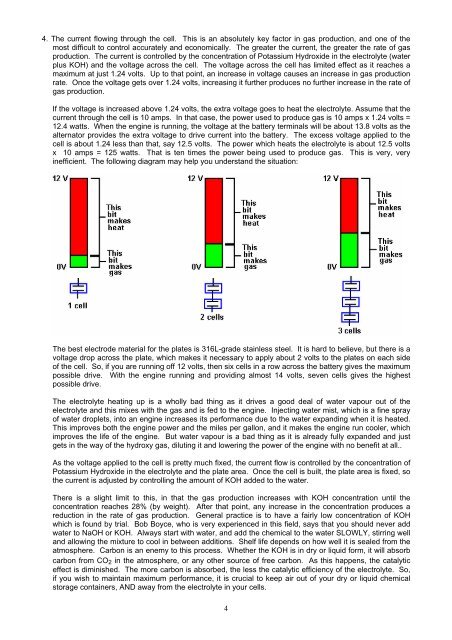Electrolyser designs - Free Energy Info
Electrolyser designs - Free Energy Info
Electrolyser designs - Free Energy Info
- No tags were found...
You also want an ePaper? Increase the reach of your titles
YUMPU automatically turns print PDFs into web optimized ePapers that Google loves.
4. The current flowing through the cell. This is an absolutely key factor in gas production, and one of themost difficult to control accurately and economically. The greater the current, the greater the rate of gasproduction. The current is controlled by the concentration of Potassium Hydroxide in the electrolyte (waterplus KOH) and the voltage across the cell. The voltage across the cell has limited effect as it reaches amaximum at just 1.24 volts. Up to that point, an increase in voltage causes an increase in gas productionrate. Once the voltage gets over 1.24 volts, increasing it further produces no further increase in the rate ofgas production.If the voltage is increased above 1.24 volts, the extra voltage goes to heat the electrolyte. Assume that thecurrent through the cell is 10 amps. In that case, the power used to produce gas is 10 amps x 1.24 volts =12.4 watts. When the engine is running, the voltage at the battery terminals will be about 13.8 volts as thealternator provides the extra voltage to drive current into the battery. The excess voltage applied to thecell is about 1.24 less than that, say 12.5 volts. The power which heats the electrolyte is about 12.5 voltsx 10 amps = 125 watts. That is ten times the power being used to produce gas. This is very, veryinefficient. The following diagram may help you understand the situation:The best electrode material for the plates is 316L-grade stainless steel. It is hard to believe, but there is avoltage drop across the plate, which makes it necessary to apply about 2 volts to the plates on each sideof the cell. So, if you are running off 12 volts, then six cells in a row across the battery gives the maximumpossible drive. With the engine running and providing almost 14 volts, seven cells gives the highestpossible drive.The electrolyte heating up is a wholly bad thing as it drives a good deal of water vapour out of theelectrolyte and this mixes with the gas and is fed to the engine. Injecting water mist, which is a fine sprayof water droplets, into an engine increases its performance due to the water expanding when it is heated.This improves both the engine power and the miles per gallon, and it makes the engine run cooler, whichimproves the life of the engine. But water vapour is a bad thing as it is already fully expanded and justgets in the way of the hydroxy gas, diluting it and lowering the power of the engine with no benefit at all..As the voltage applied to the cell is pretty much fixed, the current flow is controlled by the concentration ofPotassium Hydroxide in the electrolyte and the plate area. Once the cell is built, the plate area is fixed, sothe current is adjusted by controlling the amount of KOH added to the water.There is a slight limit to this, in that the gas production increases with KOH concentration until theconcentration reaches 28% (by weight). After that point, any increase in the concentration produces areduction in the rate of gas production. General practice is to have a fairly low concentration of KOHwhich is found by trial. Bob Boyce, who is very experienced in this field, says that you should never addwater to NaOH or KOH. Always start with water, and add the chemical to the water SLOWLY, stirring welland allowing the mixture to cool in between additions. Shelf life depends on how well it is sealed from theatmosphere. Carbon is an enemy to this process. Whether the KOH is in dry or liquid form, it will absorbcarbon from CO 2 in the atmosphere, or any other source of free carbon. As this happens, the catalyticeffect is diminished. The more carbon is absorbed, the less the catalytic efficiency of the electrolyte. So,if you wish to maintain maximum performance, it is crucial to keep air out of your dry or liquid chemicalstorage containers, AND away from the electrolyte in your cells.4
















